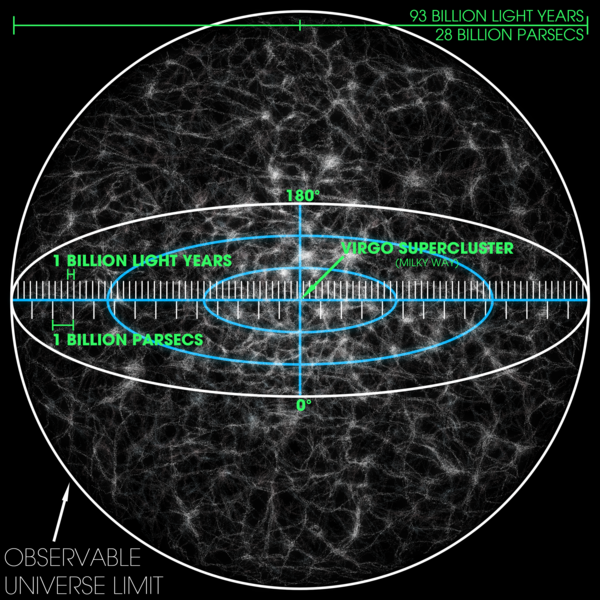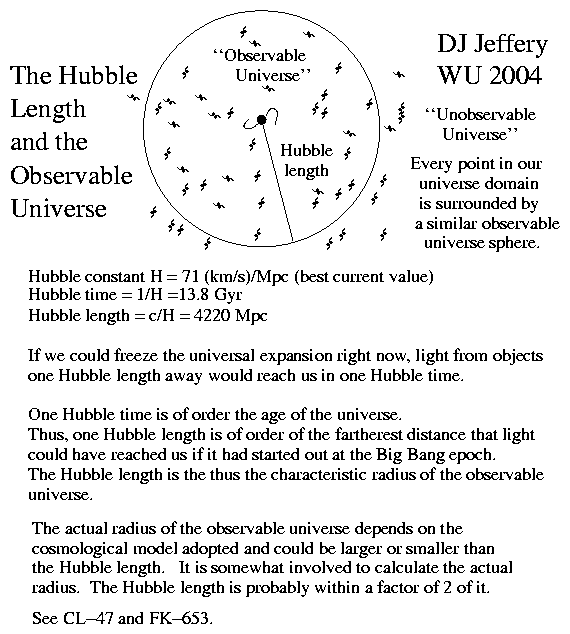
General Caption: Image 1: A diagram of the observable universe. Image 2: A cartoon observable universe embedded in a much larger surrounding outer universe.
Images:
- Image 1 Caption:
A diagram
of the observable universe
with
particle horizon
(the defined boundary of the
observable universe)
at the
comoving radius of the observable universe = 14.25 Gpc = 46.48 Gly (current value).
The cosmological value just given and those below are
according to the
Λ-CDM model
which is the favored cosmological model circa
2021, but
perhaps NOT forever.
- The Milky Way is at the center and
observable universe comoving diameter
∼ 28.5 Gpc.
- We see that
Aristotle (384--322 BCE) was half right:
the observable universe is
a sphere centered on us.
It must be since it is that part of the universe
from which a
light signal could have reached us since
the Big Bang which was time ago of the
age of the observable universe = 13.797(23) Gyr (Planck 2018)
(see Planck 2018: Age of the observable universe = 13.797(23) Gyr).
- The particle horizon
is the FARTHEST point which a light signal
(and therefore any signal) could have reached us since the
Big Bang
had the observable universe
been transparent all the time.
It was actually opaque until the
recombination era t = 377,770(3200) y
after the Big Bang
(which includes decoupling)
when the
hydrogen ions (H**(+)
and
electrons recombined and made the
observable universe transparent
to the primordial
cosmic background radiation (CBR)
which evolved into the
cosmic microwave background (CMB)
of cosmic time the present.
- Assuming the cosmological principle
that the
observable universe is
homogeneous
and isotropic
in average properties on a large enough scale,
we infer that the
observable universe everywhere
looks like the very nearby
contemporary/local universe
on average at cosmic time the present.
However, the farther you look out, the further back in cosmic time you look because of the finite vacuum light speed c = 2.99792458*10**5 km/s ≅ 3*10**5 km/s. So we see the observable universe as it looked further in the past, the farther out we look. Astronomers have this great advantage over historians: we can literally see the past.
- The diagram gives an
artist's impression
of the
large scale structure
of the observable universe whose actual realization in
reality is often called the
cosmic web.

- Image 2 Caption: A cartoon of the observable universe (characterized by the Hubble length = L_H = c/H_0 = 4.2827 Gpc/h_70 = 13.968 Gly/h_70) embedded in a much larger surrounding universe.
- The Hubble length
is a characteristic size for the class of cosmological models called the
Friedmann-Lemaitre models.
In the past,
the Hubble length
was taken as a good estimate of the
size scale of the observable universe
since there was no well established model to provide a definitely good value.
But now the Λ-CDM model gives
a precise
comoving radius of the observable universe = 14.25 Gpc = 46.48 Gly (current value),
and so the Hubble length
is less important as an estimate of the
size scale of the observable universe
than it was.
- As noted above, we have the formula
Hubble length = L_H = c/H_0 = 4.2827 Gpc/h_70 = 13.968 Gly/h_70,
where H_0 is the
Hubble constant.
The Hubble length
is a bit less than a third of the
comoving radius of the observable universe = 14.25 Gpc = 46.48 Gly (current value)
(i.e., the radius of
particle horizon).
For all larger astronomical distance scales, see Cosmology file: astronomical_distances_larger.html.
Since Hubble constant value changes a bit with every new measurement, it is convenient to write H_length in terms of the reduced Hubble constant h_70 = H_0/(70 (km/s)/Mpc) as we have done above.
The favored Hubble constant value circa 2024 is 67.4(5) (see Wikipedia: Λ-CDM model parameters). Revisions by a few percent are possible.
- Beyond the particle horizon
(i.e., the edge of the observable universe):
There is no reason to believe the particle horizon defines the boundary of the whole universe---we don't have to follow Aristotle (384--322 BCE) anymore.
So the observable universe is very probably embedded in a much larger universe which is much the same as the observable universe for a long way. This probability is because the observable universe shows no signs of a boundary and has homogeneity and isotropy: i.e., it obeys the cosmological principle.
However, well beyond the particle horizon according to the eternal inflation paradigm, there could be a boundary between our pocket universe and a false-vacuum background universe with other pocket universes.
- The Milky Way is at the center and
observable universe comoving diameter
∼ 28.5 Gpc.
-
Images:
- Credit/Permission: ©
Andrew Colvin (AKA User:Azcolvin429),
2010 /
Creative Commons
CC BY-SA 3.0.
Image link: Wikipedia: File:Observable Universe with Measurements 01.png.
- Credit/Permission: ©
David Jeffery,
2004 / Own work.
Image link: Itself.
File: Cosmology file: observable_universe_cartoon.html.